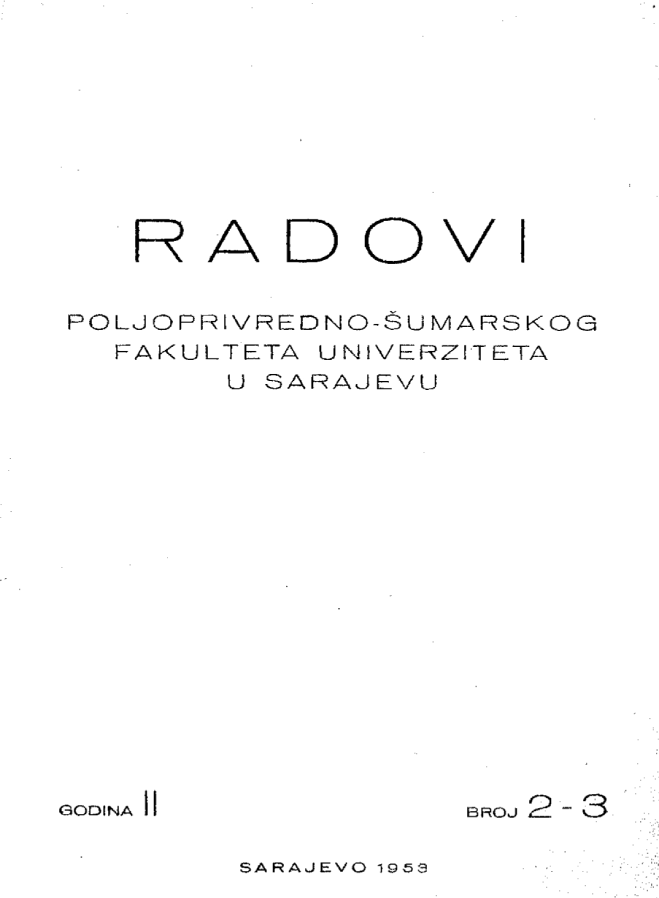PRILOG POZNAVANJU SUŠENJA LUCERKINOG SENA
DOI:
https://doi.org/10.54652/rsf.1953.v2.i2-3.320Abstract
- Detailed data are presented showing wastage and loss of alfalfa hay due to different methods of drying the green mass of lucerne. Thus, it has been observed that in drying the plant on roof-like trestles or cloverstands the rate of loss in alfalfa hay is lowest, viz.
- 5,3 % of total feeding values; crude nutii.ents:
- 09% of protein, — 7,74% of ether extract.
- 3,93% of nytx*ogen-free extract, — 0,8% of fiber, *
- 0,57% of ash.
The practice of leaving the plant to dry on the ground however, as is the general rule among the farmers in the countryside around Sarajevo, results in losses far greater than the above, viz.
- 49,9% of total feeding values; crude nutrients:
- 23,8% of protein, — 33,45% of ether extract,
- 15,5% of nytrogen-free extraxt; excess in crude fibre + 28,7%,
and in crude ash + 22,5%.
When the drying is done in cocks, the rate of loss is nearer the former than the latter, the percentage being — 16,1% as regards total feeding values, while — 4,67 of protein, — 23,0% af ether extract, and — 9,25% of nitrogen-free extract account for the loss in crude nutrients; access in crude fiber and crude ash amounts to + 7,2% and ■+• 3,28%.
With regard to chemical composition and total feeding values, the best hay has been obtained by means of drying the green mass of the plant on roof-like trestles (clover-stands); the hay in cocks has proved secondrate, and the one dried on the ground third-rate. The hay of lucerne dried on stands is a pretty shade of green, similar to the original mass of the plant; it is sweet to smell, as is the hay in cocks, the latter being slightly darker in colour with a hardly noticeable difference in aroma. The alfalfa hay made in the usual way, i, e, left to dry von the ground, has proved third-rate.
Downloads
References
Fleischmann P.: V er and errungen, welche 'bei der Dürreheuberedtung im Grase vor sich gehen. Die land, Versuchs-Stationen, Bđ. LXXVI, Parey —Berlin, 1912.
Frankland P. F., Jordan F.: Über die Gase, welche sich bei der" Umwandlung des Grases in Heu entwickeln. Chem. Centralbl., Berlin, 1883.
Hainan E. T. & Garner H. F.: The Principles and Practice of Feeding Farm Animals, London, New-York, Toronto, 1949.
Hansson N.: Fütterung der Haustiere, Leipzig und Dresden, Steinkopf — 1929.
Honcamp F.: Vergleichende Untersuchungen über die Zusammensetzung und Verdaulichkeit von frischem Gras natürlich geworbenem und durchs künstliche Trocknung gewonnenem Heu. Die landw. Versuchs-Stationen Bd. LXXXVI, Heft 3 u. 4, Parey — Berlin 1915.
Horvat B. i Nikolić D.: Ishrana domaćih životinja, Beograd, Pipred’ — 1948.
Kellner — Fingerling: Grundzüge der Fütterungslehre, P. Parey — Berlin, 1943.
Klimm er M.: Nauka o hranjenju korisnih domaćih životinja, Sarajevo 1928.
Klimmer M.: Handbuch der Ernährung und des Stoffwechsels der landwirtschaftlichen Nutztiere. Berlin 1932.
Marković F.: Porovnâni botanického rozboru lučniho sena. Sbornik Ceskoslovenské Akademie Zemëdëlské, Roenik XXII, Sešit 1, Praha 1949.
Morrison B. F.: Feed and Feeding, The Morrison Publishing, Ithaca —New-York, 1951.
Popov I. S.: Ishrana domaćih životinja, Naučna knjiga, Beograd — 1949.
Svoboda F.: Vÿsledky pokusu s rozlicnÿmi zpûsoby sušeni vojtëèky, Sborailk Ceské Akademie Zemëdëlské, Praha 1939.
Smalcel j I.: Malà hranidba domaći11 životinja, Cvitković, Zagreb 1945.
Smalcelj I,: Pitanje krmne baze, njene rekonstrukcije i povećanje u vezi sa petogodišnjim planom i perspektivnim razvitkom stočarstva, —
Stočarstvo, Zagreb 1949.
Šoštarić Pisačić K.: Sušenje krme, Kalendar Gospodarske sloge, Zagreb 1938.
Šoštarić Pisačić K.: Utjecaj košnje i sušenja na kvalitet i količinu sijena. Min. polj. Zagreb — 1948,
Tomme I, F.: Ishrana domaćih životinja, P. N. Z., Zagreb — 1948.
Turin a B.: Livade i pašnjaci, Zagreb 1948.
Zubrilin A. A.: Naučnije osnovi konservirovania zelenih kormov, Moskva — 1948.
Zubrilin A. A.: K teorii šuški trav na seno, Dokladi br. 5, Moskva 1948-























